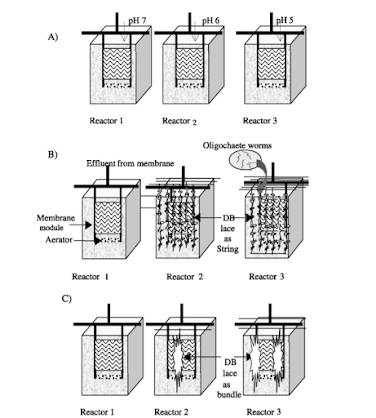SLUDGE REDUCTION POTENTIAL OF METAZOA
A way to reduce excess sludge production and enhance mineralization is to retain the sludge completely in a treatment plant, which can be achieved by a membrane separation process. There the sludge concentration is expected to stabilize at the level at which energy supplied is fully utilized for maintenance purpose. Another way to enhance mineralization and reduce the sludge production is to exploit the organism in the process that predate on bacteria (sludge), by promoting their growth in an extra “grazing stage”. During energy transfer from bacteria to higher trophic level organisms, energy is lost due to inefficient biomass conversion and thus the predator may make a large contribution to biomass replacement. A long sludge retention period in membrane bioreactors (MBR) is very suitable for the abundant growth of these higher organisms. This predatory population in the system can be exploited to enhance mineralization and reduce sludge production.
High metazoa density leads to high mineralization rate. Metazoa or worms inside a system cause the relatively bigger floc particles to go under predation pressure and in this process their transformation into smaller particles increases. Again smaller flocs inside the reactor are preferable for mineralization, hydrolysis and predation by the other predator organisms like protozoa. But in an activated sludge system, grazing fauna mainly consist of protozoa and occasionally metazoa, such as rotifer and nematode. Higher life forms such as Tubificidae are less due to the lack of suitable niches and introduction of carrier material inside the system may improve the growth condition for these higher metazoa as well as the other predator organisms.
Though metazoa was not found to be so effective at creating a significant change in the sludge reduction, it might have potential for fouling control. It was found the in the membrane of a reactor with more number of metazoa, the formation of cake layer due to the sludge was also minimum. This suggested that the attached metazoa play a significant role in removing accumulated sludge from the membrane surface. After several experiments done on metazoa, it was concluded that metazoa population about 1,000–2,000 per ml was not effective to reduce sludge production in the accumulation phase in MBR. But metazoa population was found to play an effective role in fouling control of the membrane, especially those that were attached to the membrane. A satisfactory level of biomass accumulation was not observed in the DB lace used as a carrier material for improving the living environment of the metazoa.
Reference : Research paper of 'Sludge reduction potential of metazoa in membrane bioreactors' By B.S. Luxmy, T. Kubo and K. Yamamoto.
https://pdfs.semanticscholar.org/3975/a2ede937bb40ff840f779c12f8cda3101d18.pdf


Excellent
ReplyDeleteSupreme work
ReplyDeleteGood experiment...
ReplyDeleteExcellent
ReplyDeleteExcellent Work 👌
ReplyDeleteWell done👍
ReplyDeleteWell done. Great job
ReplyDeleteGreat going !
ReplyDeleteWonderful dear
ReplyDeleteSuperb.
ReplyDeleteVery good
ReplyDeleteExcellent work
ReplyDeleteGreat work
ReplyDeleteGreat job!
ReplyDeleteThis comment has been removed by the author.
ReplyDeleteGreat job
ReplyDeleteFouling control is definitely very critical and your blog explains how metazoa population play an effective in fouling control👍👍👍
ReplyDeleteAwesome work
ReplyDelete